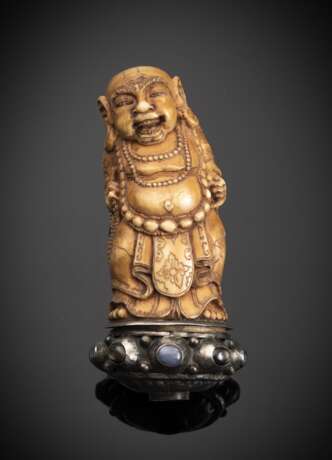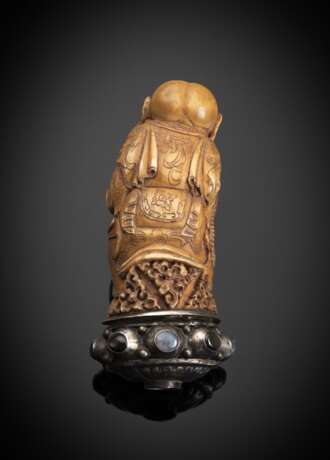ID 1218054
Lot 1537 | Keris -Griff aus Elfenbein
Estimate value
€ 1 000 – 1 500
H. 11,5 cm
Figuraler Keris-Griff, Elfenbein geschnitzt (generische Bezeichnung für figurale Griffe: togog, deling). Der Griff stellt eine lachende kahlköpfige Priestergestalt mit Gebetsschnur dar, mit sechs Punkten auf der Stirn. Die Figur hat große Ohrläppchen, ein typisches Merkmal von Glücksgöttern und Heiligen in China und Japan. Chinesische Einflüsse sind im Stil der Figur klar erkennbar. Die buddhistischen Einflüsse im javano-balinesischen Hinduismus sind teilweise signifikant. Die Gestaltung des Griffes als Ganzes erweckt phallische Konnotationen, man beachte die Gestaltung des Hinterkopfs und die Tuchfalten im Nacken. Silber-selut mit hellblauen Schmucksteinen und Tigeraugen. Die Gebetsschnur ist hinduistischen Helden und Gottheiten gemein und geht auf das indo-arische Lasso der Viehzüchter zurück, die in der Bronze- und frühen Eisenzeit in Nord-Indien sukzessive einwanderten und die vedische Tradition begründeten. Aus dem sino-japanischen Bereich sind daoistische Heilige und Gottheiten wie Jurojin und Fukurokuju oft phallisch bzw. sexuell konnotiert. Ein hoher Kopf transportiert eine latent phallische Aussage, da der Kopf im chinesischen Daoismus als sexuelles Empfindungszentrum und als „Speicher allen Spermas“ gewertet wird, was mit Lebenskraft und Fruchtbarkeit gleichgesetzt wird. Oft handelt es sich um vor-buddhistische lokale Landwirtschafts- und Fruchtbarkeitsgottheiten, die als „Unsterbliche“ (xian) oder buddhistische Heilige (luohan, arhat) eine Neubewertung erfuhren. Ihnen ist meist ein fröhlicher bis exaltierter Habitus und Beleibtheit eigen, was von den Adoranten mit Reichtum und Erfolg assoziiert wird (auch wenn die Mönche selbst asketisch lebten). Eine weitere Bedeutungsebene der dickbäuchigen Priester sind die gana, die meist grotesk dargestellten Anhänger des Shiva Bhairava oder Shiva Kalashtami (Shiva als Vernichter oder als Kriegsherr).
Aus einer alten deutschen Privatsammlung seit den 1950er Jahren gesammelt - Minim. berieben
Lit.: IFICAH (2015): Götter-Schmiede. Balinesische Zeremonialklingen im kulturellen Kontext. Wohlesbostel. - Neka, P.W.S. (2010): Keris Bali Bersejarah. Neka Art Museum, Ubud. - Ramseyer, U. (1977): Bali. Leben in zwei Welten. Zürich.
| Auction house category: | Ethnographic tribal art |
|---|
| Auction house category: | Ethnographic tribal art |
|---|
| Address of auction |
Nagel Auktionen GmbH Neckarstrasse 189 - 191 70190 Stuttgart Germany | ||||||||||||||
|---|---|---|---|---|---|---|---|---|---|---|---|---|---|---|---|
| Preview | |||||||||||||||
| Phone | +49 (0)711 649 690 | ||||||||||||||
| Fax | +49 (0)711 649 69696 | ||||||||||||||
| Buyer Premium | 29,5% | ||||||||||||||
| Conditions of purchase | Conditions of purchase | ||||||||||||||
| Business hours | Business hours
|




